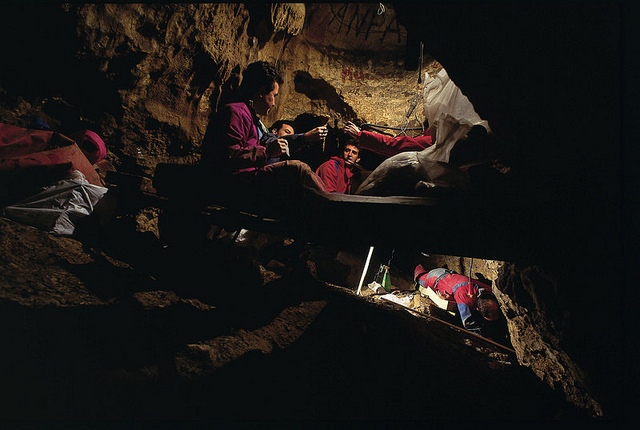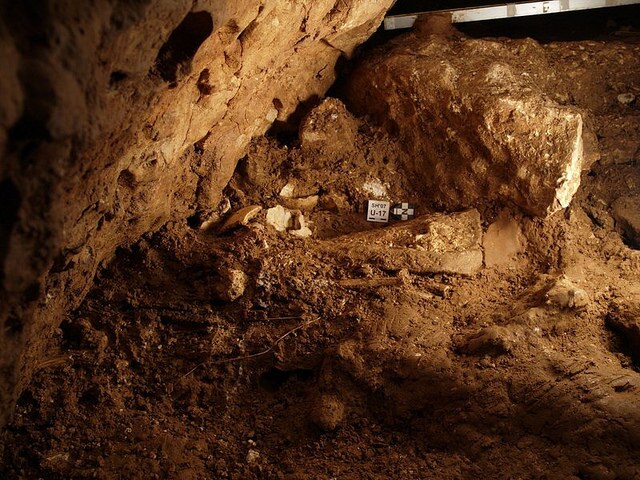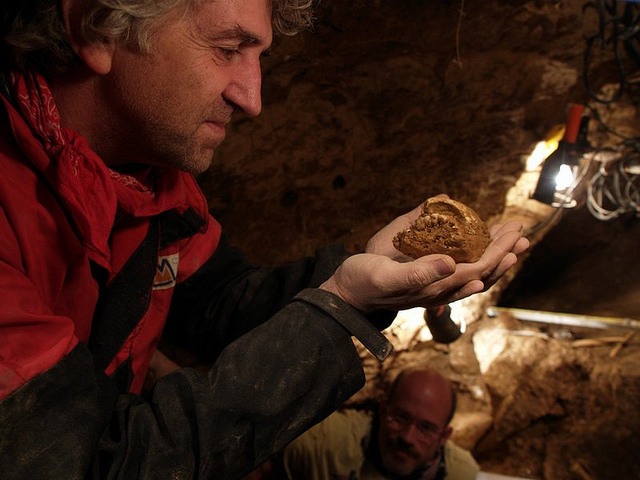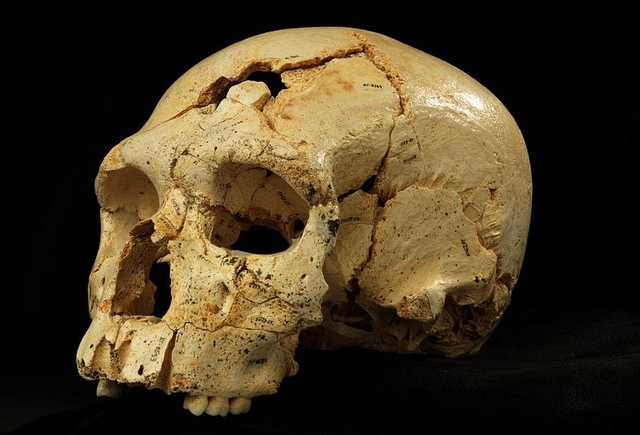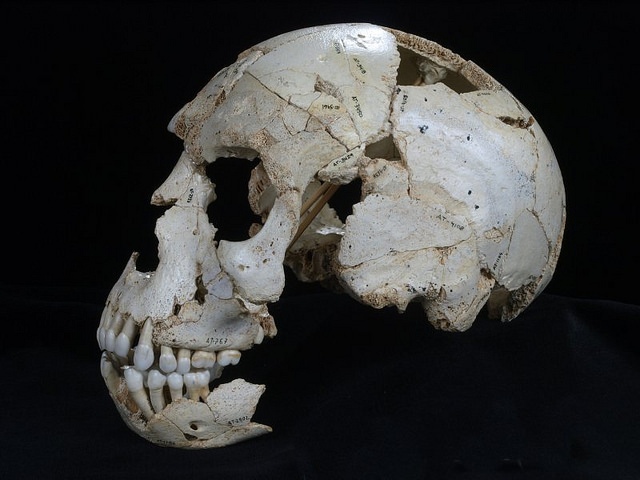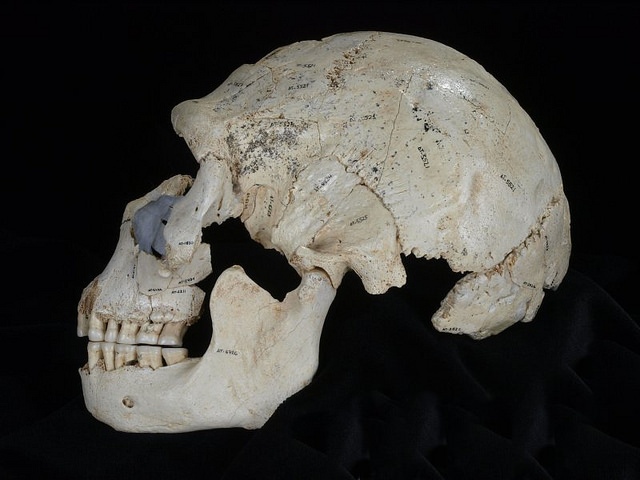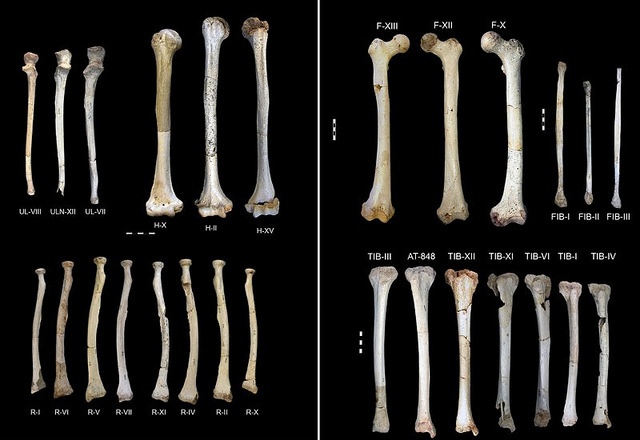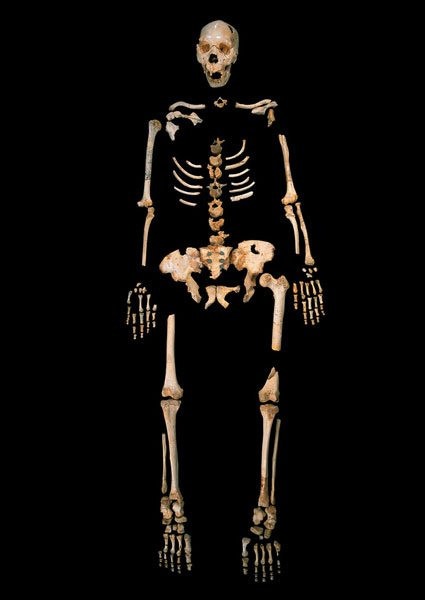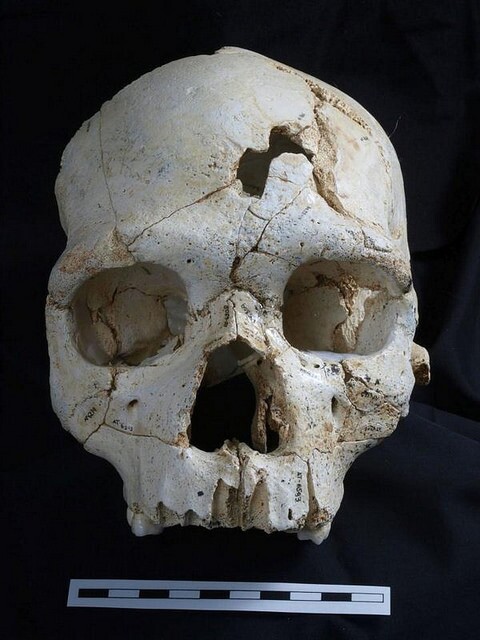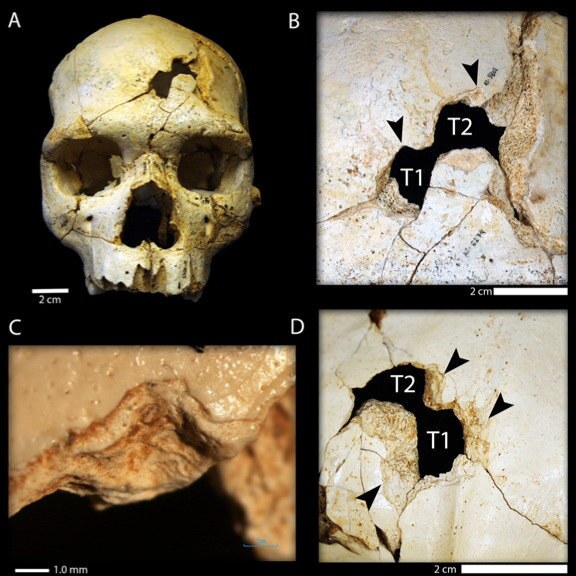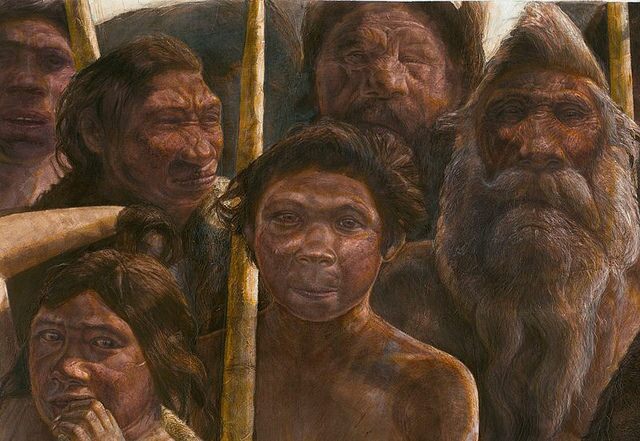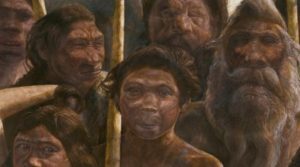
They looked something like Neanderthals. But they weren’t classic Neanderthals. Not exactly.
For one thing, they lived 430,000 years ago in what is today northern Spain. Neanderthals have not been traditionally known, at least by the fossil evidence, to have walked the earth at that time. The oldest recovered classic Neanderthal fossil dates to about 200,000 years ago, though many scientists have suggested that Neanderthals lived more anciently, as their distinctive stone tools, known as the Mousterian industry, have been dated to far earlier times.
Were these humans ancestral to Neanderthals? Possibly so. But the people most familiar with their bones, scientists like Juan Luis Arsuaga of the Centro Mixto Universidad Complutense of Madrid, Spain, are saying that they might have been something else.
The Bone Studies
Their bones were excavated by Arsuaga and his team beginning in 1997 within a subterranean chamber created by nature at the terminus of a natural vertical 13-meter subterranean karstic shaft. Spelunkers and scientists call it the “chimney”, and for good reason—it’s a bit like negotiating down the interior of a house chimney. Entering the shaft can only be done by traversing through yet another, much larger cave—Cueva Mayor—part of a larger karstic mountain complex in northern Spain called Atapuerca. Atapuerca is important because here in the caves of these mountains scientists have found fossils and stone tools of some of the earliest known humans in Western Europe, and this small cave at the end of the vertical shaft is arguably the star of the show. Here, over a period of more than two decades, teams of archaeologists and other specialists have excavated over 6,700 human fossils of at least 28 individuals, individuals who lived more than 400,000 years ago. Aptly named Sima de los Huesos (“Sima”), or “Pit of Bones”, it is to date the largest single assembly of early human fossil remains ever found at any single site in the world. The new questions precipitated by the findings at the site have stirred the scholarly world of human evolution. Dating to 430,000 years ago, “this unique collection has to be compared with the much more fragmentary and generally isolated remains yielded by other Middle Pleistocene sites in Europe and out of Europe,” said Arsuaga. It offered Arsuaga and his team a unique opportunity to study a scene on the stage of the evolution of Middle Pleistocene humans, an unprecedented collection of fossils representing a single population of a hominin (early human) species.
____________________________________________
The team at work inside the cave: The Sima de los Huesos site. Image courtesy Javier Trueba / Madrid Scientific Films
_____________________________________________
The location within the Sima de los Huesos site where the bones were unearthed. This image relates to a paper that appeared in the 20 June, 2014, issue of Science, published by AAAS. The paper, by Juan-Luis Arsuaga at Centro Mixto UCM-ISCIII de Evolución y Comportamiento Humanos in Madrid, Spain, and colleagues was titled, ‘Neandertal roots: Cranial and chronological evidence from Sima de los Huesos.’ Image courtesy Javier Trueba / Madrid Scientific Films
____________________________________________
Professor Juan Luis Arsuaga holds one of the many fossil specimens found at the site. This image relates to a paper that appeared in the 20 June, 2014, issue of Science, published by AAAS. The paper, by Juan-Luis Arsuaga at Centro Mixto UCM-ISCIII de Evolución y Comportamiento Humanos in Madrid, Spain, and colleagues was titled, ‘Neandertal roots: Cranial and chronological evidence from Sima de los Huesos.’ Image courtesy Javier Trueba / Madrid Scientific Films
_____________________________________________
After excavation, extensive analysis first centered on 17 skulls. Although some of them had been studied before, seven have been presented anew, and six are now more complete than ever before, after many hours of painstaking reconstruction in the lab. With these mostly intact samples for study, the researchers were beginning to more clearly define the common features of this population. Most striking, the examiners found that the fossils exhibited a mosaic of physical characteristics that could not be wholly attributed to any single, recognized human species to date. The skull samples showed clear Neanderthal features in the face and teeth. The researchers suggested the ‘Neanderthal-derived’ features were functionally related to mastication, or chewing. “It seems these modifications had to do with an intensive use of the frontal teeth,” Arsuaga said. “The incisors show a great wear as if they had been used as a ‘third hand,” typical of Neanderthals.” But elsewhere, the skulls showed characteristics that diverged from the Neanderthal model. The braincase itself, for example, still showed features associated with more primitive hominins. The crania or skulls were indicating that these were not really Neanderthals*
_____________________________________________
Reconstructed skull 17 from the Sima de los Huesos site in Sierra de Atapuerca, Spain. This image relates to a paper that appeared in the 20 June, 2014, issue of Science, published by AAAS. The paper, by Juan-Luis Arsuaga at Centro Mixto UCM-ISCIII de Evolución y Comportamiento Humanos in Madrid, Spain, and colleagues was titled, ‘Neandertal roots: Cranial and chronological evidence from Sima de los Huesos.’ Image courtesy Javier Trueba / Madrid Scientific Films
______________________________________________
Reconstructed Skull 9. This image relates to a paper that appeared in the 20 June, 2014, issue of Science, published by AAAS. The paper, by Juan-Luis Arsuaga at Centro Mixto UCM-ISCIII de Evolución y Comportamiento Humanos in Madrid, Spain, and colleagues was titled, ‘Neandertal roots: Cranial and chronological evidence from Sima de los Huesos.’ Image courtesy Javier Trueba / Madrid Scientific Films
_______________________________________________
Reconstructed Skull 15. This image relates to a paper that appeared in the 20 June, 2014, issue of Science, published by AAAS. The paper, by Juan-Luis Arsuaga at Centro Mixto UCM-ISCIII de Evolución y Comportamiento Humanos in Madrid, Spain, and colleagues was titled, ‘Neandertal roots: Cranial and chronological evidence from Sima de los Huesos.’ Image courtesy Javier Trueba / Madrid Scientific Films
_______________________________________________
Above: A video inside look of the team at work inside the cave. Courtesy Madrid Scientific Films
______________________________________________
Next, the team examined the bones of the postcranial skeletons—all bones other than the skulls. They closely examined and measured 1,523 fossil elements from the collection, representing a minimum number of 19 individuals, using raw values for key skeletal parts as proxies to estimate stature, body breadth, and weight. They also compared the results for the same values from data derived from other early human fossils, including hominins dated to much earlier times. From these results, they were able to characterize the body design of postcranial skeletons, finding that these individuals were relatively tall (by early human standards), with wide, muscular bodies. Although similarly built to Neanderthals, they had generally less brain mass than the classic Neanderthals. They were shorter, wider and more robust than the much later Homo sapiens, or modern humans (MH), with less brain to body mass. Like the results of the skull study, the researchers observed that these humans shared many anatomical features with Neanderthals, although some other key Neanderthal features were not present.**
______________________________________________
This image shows the upper and lower limb bones of those adults found in Sima de los Huesos, Atapuerca, Spain. Image from Carretero et al.
______________________________________________
This is a complete Sima skeleton assembled from samples excavated at Sima de los Huesos. Image courtesy Javier Trueba, Madrid Scientific Films
______________________________________________
So what did these findings mean?
“Morphologically, the Sima de los Huesos skulls [and postcranial skeleton] exhibit some (generally incipient) Neanderthal traits,” said Arsuaga. “These traits have been scrutinized to understand how the Neanderthal specializations developed……..and it is now clear that the full suite of Neanderthal characteristics did not evolve at the same pace.” However, according to Arsuaga,”we think based on the morphology that the Sima people were part of the Neanderthal clade, although not necessarily direct ancestors to the classic Neanderthals.”
“Not necessarily direct ancestors” was an operative statement, because another study, conducted by Matthias Meyer and a team from the Max Planck Institute for Evolutionary Anthropology in Leipzig, Germany, indicated a genetic connection of the Sima group to Denisovans, a newly discovered extinct human species that heretofore had been known to exist primarily in Asia at least 40,000 years ago. Those researchers found that the Sima group shared a common ancestor with the Denisovans about 700,000 years ago. “The fact that the mtDNA of the Sima de los Huesos hominin shares a common ancestor with Denisovan rather than Neanderthal mtDNAs is unexpected since its [the Sima hominin] skeletal remains carry Neanderthal-derived features”, said Meyer. According to Meyer and colleagues, the age and Neanderthal-like features of the Sima hominins pointed to the possibility that they may have been related to a population ancestral to both Neanderthals and Denisovans. Another possibility, according to Meyers, is that gene flow from a different group of hominins introduced Denisova-like mtDNA into the Sima hominins or their ancestors.***
More recent sequencing[1] of the nuclear DNA taken from a tooth and leg bone has produced some startling new results, however. As reported by Meyer, the results of that sequencing has suggested that the Sima group was likely more closely related to Neanderthals than they had previously suspected, possibly even as a direct ancestor to Neanderthals. Moreover, the results of the study suggested that the origins of the Neanderthals may need to be pushed significantly back further into time.
Thus, the Sima collection represented an ancestral or sister ancestral group to later Neanderthals, with the findings indicating that the features that distinguished the Neanderthals did not evolve as a single package, but separately in different groups, in a mosaic pattern that eventually came together in the species we know today as classic Neanderthal. The uptake: Human evolution, at least in what is today western Europe, was likely far more complex than the traditional single line paradigm suggested.
The Million Year Stasis
But there was another important observation.
By comparing the postcranial fossils to those of other ancient humans, particularly the earlier hominin species that made up the Homo genus (the genus to which Neanderthals and modern humans belong), the researchers also noted that the generally wide Sima skeleton body plan provided additional evidence that early humans, before Homo sapiens, changed relatively little in this respect over the one million years preceding the rise of modern humans.
“This is really interesting,” said Binghamton University anthropologist Rolf Quam, a study participant, “since it suggests that the evolutionary process in our genus is largely characterized by stasis (i.e., little to no evolutionary change) in body form for most of our evolutionary history.”
It wasn’t until modern humans, in other words, that humans became taller, narrower, and lighter—along with a greater brain mass to body mass ratio (more encephalized)—a result, some scientists suggest, that reflected evolutionary engineering for greater efficiency, survival and adaptability.
The Pit of Bones—A Funerary Site?
So what were the bones of 28 individuals doing in this nearly inaccessible little chamber at the bottom of a difficult-to-negotiate shaft?
It wasn’t an ancient living space. Its size and location, along with the distinct lack of tell-tale evidence of human habitation, precludes this possibility. One thing for sure, however, the skeletal remains represented whole individuals. Although the bones were accompanied by bones of an extinct species of bear, the pattern didn’t indicate that the bone elements were randomly washed down into the cavity from the outside by nature over time or carried into the location by bears or other predators.
Another possible clue came from a recent fascinating finding by another international team of scientists. Led by Nohemi Sala from Centro Mixto UCM-ISCIII de Evolución y Comportamiento Humanos, Spain, this team of researchers examined one particularly peculiar Sima skull (‘Cranium 17’) using modern forensic techniques, including stereoscopic light and digital microscopes, an industrial CT scanner, 3D imaging technology, and contour and trajectory analysis. They focused on two unusual holes or lesions on the frontal bone above the left eye. They were unlike many of the bone fractures on the other bones recovered from the site, which by examination were shown to have been caused by geological process disturbances or as a result of having fallen down a vertical shaft into the cave, perhaps by accident. The results of the study indicated that both fractures were likely produced by two separate impacts by the same object with slightly different trajectories at the same time. According to the researchers, the nature of the lesions indicated that they were likely lethal, and unlikely the result of an accidental fall down the vertical shaft. Rather, the type of fracture, their location, and the appearance of having been produced by two blows with the same object, led the researchers to interpret them as the result of an act of lethal interpersonal aggression. In other words, Sala and his team uncovered what is likely the oldest known case of murder, or violent lethal interpersonal interaction, in human history. Moreover, and most relevant to the interpretation of the site, the study results indicated that the individual was already dead before arrival at the cave site, suggesting that the person was carried to the top of the vertical shaft of the cave and deposited by other humans.
_____________________________________________
Frontal view of Cranium 17 showing the position of the traumatic events T1 (inferior) and T2 (superior). Courtesy Javier Trueba / Madrid Scientific Films
______________________________________________
Shown above: The Cranium (Skull) 17 bone traumatic fractures. (A) Frontal view of Cranium 17 showing the position of the traumatic events T1 (inferior) and T2 (superior); (B) Detailed ectocranial view of the traumatic fractures showing the two similar notches (black arrows) present along the superior border of the fracture outlines. Note that the orientation of the two traumatic events is different; (C) Detail of the notch in T1 under 2X magnification with a light microscope. (D) Endocranial view of T1 and T2 showing the large cortical delamination of the inner table (black arrows). From Sala N, Arsuaga JL, Pantoja-Pérez A, Pablos A, Martínez I, Quam RM, et al. (2015) Lethal Interpersonal Violence in the Middle Pleistocene. PLoS ONE 10(5): e0126589. doi:10.1371/journal. pone.0126589
______________________________________________
Thus, combined with what scientists already knew about the site and its contents, the finding also led the researchers to another significant conclusion: Given the nature, position, abundance and condition of human bones found within the cave, “the interpretation of the SH site as a place where hominins deposited deceased members of their social groups seems to be the most likely scenario to explain the presence of human bodies at the site,” wrote the study authors in the report. “This interpretation implies this was a social practice among this group of Middle Pleistocene hominins and may represent the earliest funerary behavior in the human fossil record.”****
So the Pit of Bones was the prehistoric equivalent of a mass grave or cemetery?
Perhaps, but study of the site and its contents is ongoing. If anything, experience has shown that there may be more surprises to come.
______________________________________________________________
Artist’s depiction of the Sima de los Huesos humans. Group picture – no matter what we did, we couldn’t get them to smile. Life was hard 430,000 years ago. Courtesy Javier Trueba, Madrid Scientific Films
__________________________________________________________
*J.L. Arsuaga et al., Neandertal roots: Cranial and chronological evidence from Sima de los Huesos, Science, 20 June 2014, Vol. 344 no. 6190
**Juan-Luis Arsuaga et al., Postcranial morphology of the middle Pleistocene humans from Sima de los Huesos, Proceedings of the National Academy of Sciences, www.pnas.org/cgi/doi/10.1073/pnas.1514828112
***Matthias Meyer et al., A mitochondrial genome sequence of a hominin from Sima de los Huesos, Nature, 4 December 2013 (DOI: 10.1038/nature12788)
[1]Ann Gibbons, DNA from Neandertal relative may shake up human family tree, Science, 11 September 2015.
****Sala N, Arsuaga JL, et al., Lethal Interpersonal Violence in the Middle Pleistocene. PLoS ONE 2015 10(5): e0126589. doi:10.1371/journal. pone.0126589
_______________________________________________________________

